Marks and Spencer (Food) SBU: Internal and External Analysis Report
VerifiedAdded on 2021/04/05
|18
|4622
|83
Report
AI Summary
This report provides a comprehensive analysis of Marks and Spencer (M&S) Food as a Strategic Business Unit (SBU). It begins with an introduction to M&S's history and its current market position, focusing on the Food division. The internal analysis examines the strengths and weaknesses of M&S Food, including its brand reputation, product range, customer experience, and healthy food options, as well as challenges related to promotions, delivery, technology, and supplier issues. Stakeholder expectations and value chain analysis, covering inbound logistics, operations, outbound logistics, marketing and sales, and service, are also discussed. The external analysis utilizes PESTEL and Porter's Five Forces to assess the political, economic, social, technological, environmental, and legal factors impacting the business, as well as the competitive dynamics within the retail sector. The report also includes a strategic group analysis to understand the competitive landscape and M&S's positioning relative to its competitors, highlighting challenges related to pricing, location, and customer satisfaction. The report concludes with an overview of competition within the market.
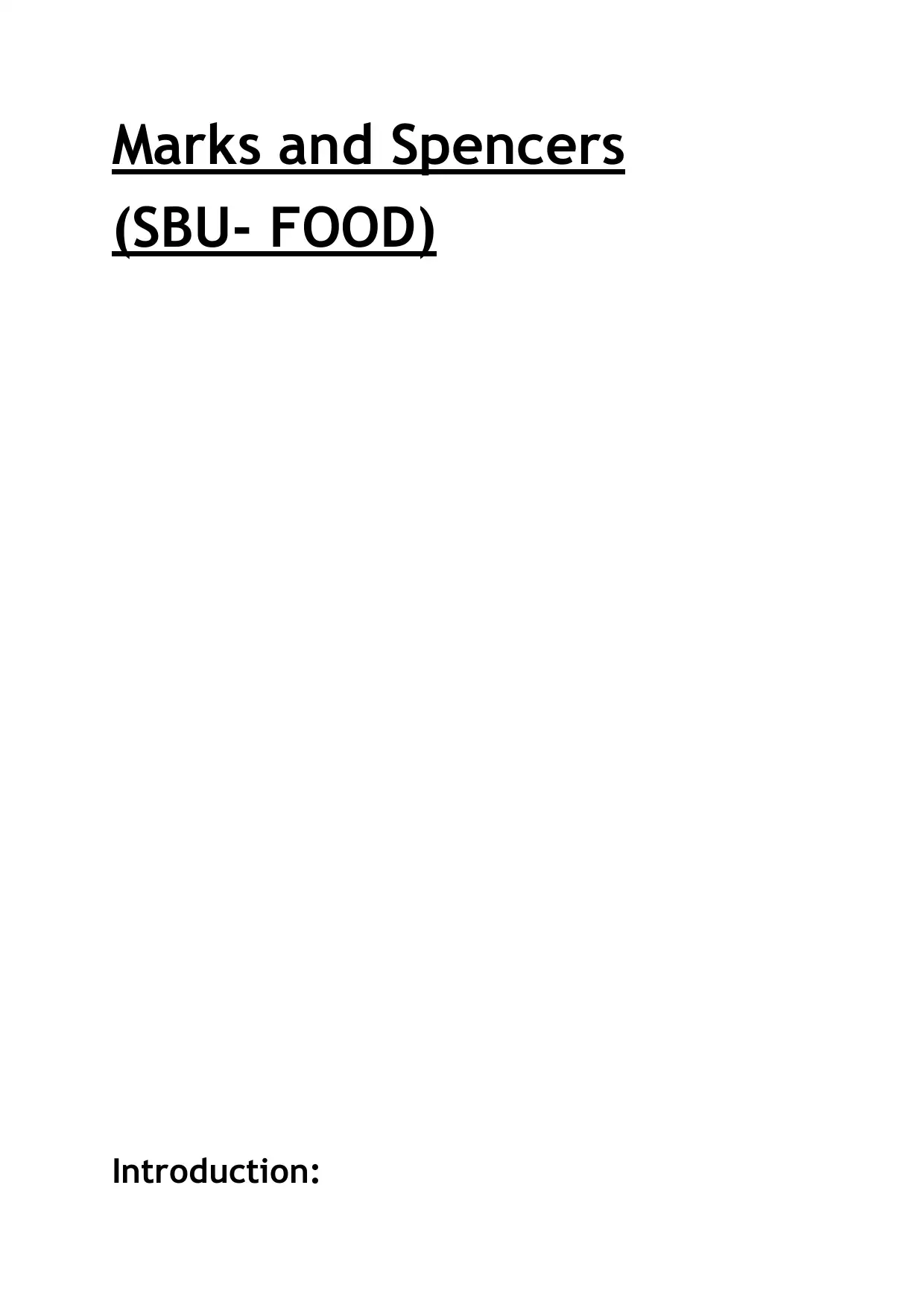
Marks and Spencers
(SBU- FOOD)
Introduction:
(SBU- FOOD)
Introduction:
Paraphrase This Document
Need a fresh take? Get an instant paraphrase of this document with our AI Paraphraser

On 28th September 1884, Marks & Spencer was formed as a partnership between
Michael Marks and Thomas Spencer. They started selling basic groceries like
cookies, needle, thread, buttons. They provided opportunity to consumers to do
window shopping that is they can take a glance of the products without paying any
amount. After the success, they opened 35 more stores in earlier 1900. The
company's 914 UK outlets-222 managed and 349 Simply Grocery stores franchises
as well as 302 full-line apparel and home stores and an e-commerce site of over
seven million registered users service 33 million consumers with a turnover of £ 5.2
billion and £ 4.0 billion in two divisions (food and general merchandise). M&S is a
market leader in womenswear, menswear, and lingerie in the UK market. The foreign
business of the group, which consists of 468 wholly owned, jointly owned.
This assessment will be divided into two parts A and B focusing in “Food” as
strategic business unit. Firstly we shall discuss Internal analysis followed by a small
summary, similarily, external analysis followed by business strategy used by M&S. In
the end of Part A
Internal Analysis of M&S Food
Michael Marks and Thomas Spencer. They started selling basic groceries like
cookies, needle, thread, buttons. They provided opportunity to consumers to do
window shopping that is they can take a glance of the products without paying any
amount. After the success, they opened 35 more stores in earlier 1900. The
company's 914 UK outlets-222 managed and 349 Simply Grocery stores franchises
as well as 302 full-line apparel and home stores and an e-commerce site of over
seven million registered users service 33 million consumers with a turnover of £ 5.2
billion and £ 4.0 billion in two divisions (food and general merchandise). M&S is a
market leader in womenswear, menswear, and lingerie in the UK market. The foreign
business of the group, which consists of 468 wholly owned, jointly owned.
This assessment will be divided into two parts A and B focusing in “Food” as
strategic business unit. Firstly we shall discuss Internal analysis followed by a small
summary, similarily, external analysis followed by business strategy used by M&S. In
the end of Part A
Internal Analysis of M&S Food
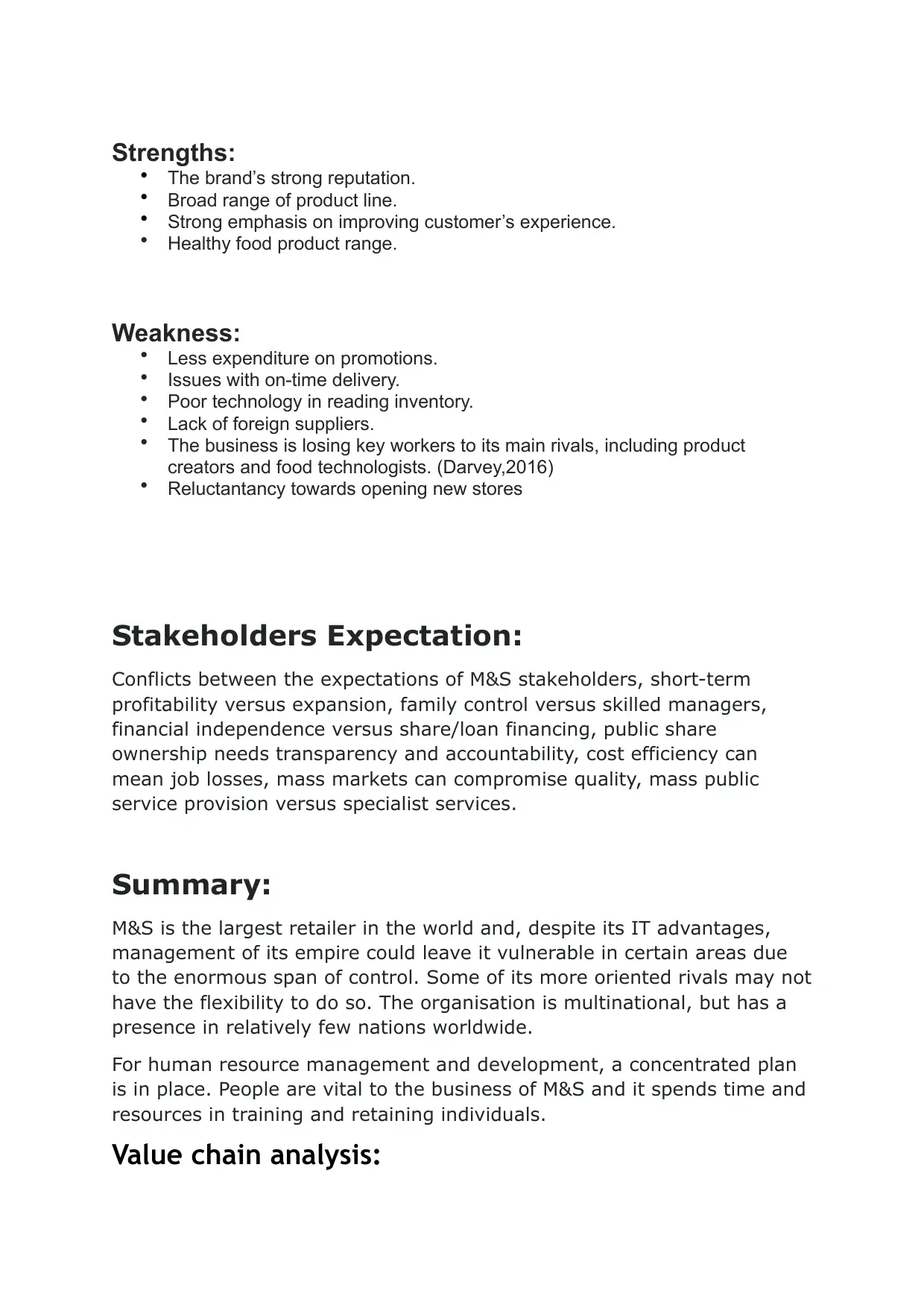
Strengths:
• The brand’s strong reputation.
• Broad range of product line.
• Strong emphasis on improving customer’s experience.
• Healthy food product range.
Weakness:
• Less expenditure on promotions.
• Issues with on-time delivery.
• Poor technology in reading inventory.
• Lack of foreign suppliers.
• The business is losing key workers to its main rivals, including product
creators and food technologists. (Darvey,2016)
• Reluctantancy towards opening new stores
Stakeholders Expectation:
Conflicts between the expectations of M&S stakeholders, short-term
profitability versus expansion, family control versus skilled managers,
financial independence versus share/loan financing, public share
ownership needs transparency and accountability, cost efficiency can
mean job losses, mass markets can compromise quality, mass public
service provision versus specialist services.
Summary:
M&S is the largest retailer in the world and, despite its IT advantages,
management of its empire could leave it vulnerable in certain areas due
to the enormous span of control. Some of its more oriented rivals may not
have the flexibility to do so. The organisation is multinational, but has a
presence in relatively few nations worldwide.
For human resource management and development, a concentrated plan
is in place. People are vital to the business of M&S and it spends time and
resources in training and retaining individuals.
Value chain analysis:
• The brand’s strong reputation.
• Broad range of product line.
• Strong emphasis on improving customer’s experience.
• Healthy food product range.
Weakness:
• Less expenditure on promotions.
• Issues with on-time delivery.
• Poor technology in reading inventory.
• Lack of foreign suppliers.
• The business is losing key workers to its main rivals, including product
creators and food technologists. (Darvey,2016)
• Reluctantancy towards opening new stores
Stakeholders Expectation:
Conflicts between the expectations of M&S stakeholders, short-term
profitability versus expansion, family control versus skilled managers,
financial independence versus share/loan financing, public share
ownership needs transparency and accountability, cost efficiency can
mean job losses, mass markets can compromise quality, mass public
service provision versus specialist services.
Summary:
M&S is the largest retailer in the world and, despite its IT advantages,
management of its empire could leave it vulnerable in certain areas due
to the enormous span of control. Some of its more oriented rivals may not
have the flexibility to do so. The organisation is multinational, but has a
presence in relatively few nations worldwide.
For human resource management and development, a concentrated plan
is in place. People are vital to the business of M&S and it spends time and
resources in training and retaining individuals.
Value chain analysis:
⊘ This is a preview!⊘
Do you want full access?
Subscribe today to unlock all pages.

Trusted by 1+ million students worldwide
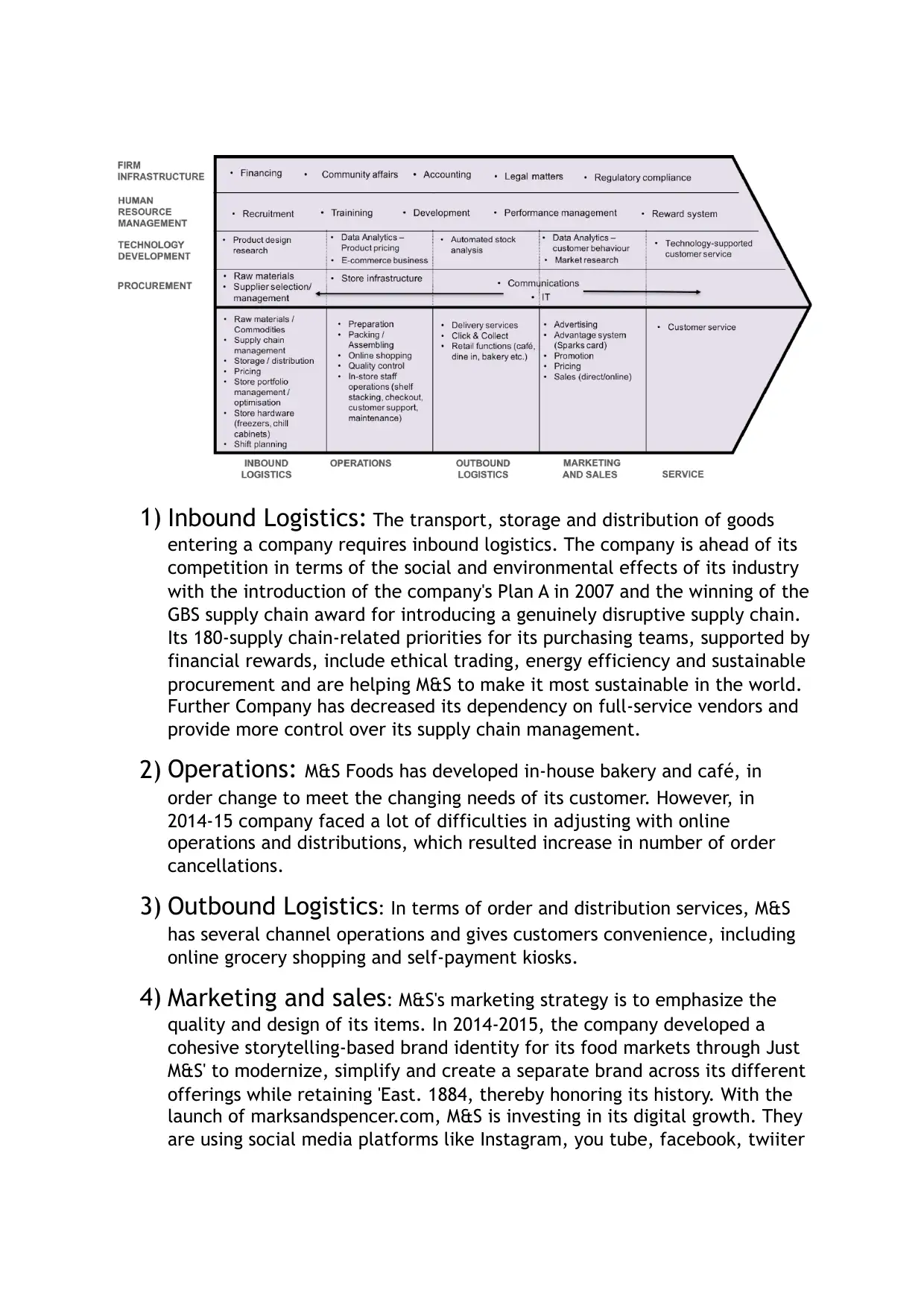
1) Inbound Logistics: The transport, storage and distribution of goods
entering a company requires inbound logistics. The company is ahead of its
competition in terms of the social and environmental effects of its industry
with the introduction of the company's Plan A in 2007 and the winning of the
GBS supply chain award for introducing a genuinely disruptive supply chain.
Its 180-supply chain-related priorities for its purchasing teams, supported by
financial rewards, include ethical trading, energy efficiency and sustainable
procurement and are helping M&S to make it most sustainable in the world.
Further Company has decreased its dependency on full-service vendors and
provide more control over its supply chain management.
2) Operations: M&S Foods has developed in-house bakery and café, in
order change to meet the changing needs of its customer. However, in
2014-15 company faced a lot of difficulties in adjusting with online
operations and distributions, which resulted increase in number of order
cancellations.
3) Outbound Logistics: In terms of order and distribution services, M&S
has several channel operations and gives customers convenience, including
online grocery shopping and self-payment kiosks.
4) Marketing and sales: M&S's marketing strategy is to emphasize the
quality and design of its items. In 2014-2015, the company developed a
cohesive storytelling-based brand identity for its food markets through Just
M&S' to modernize, simplify and create a separate brand across its different
offerings while retaining 'East. 1884, thereby honoring its history. With the
launch of marksandspencer.com, M&S is investing in its digital growth. They
are using social media platforms like Instagram, you tube, facebook, twiiter
entering a company requires inbound logistics. The company is ahead of its
competition in terms of the social and environmental effects of its industry
with the introduction of the company's Plan A in 2007 and the winning of the
GBS supply chain award for introducing a genuinely disruptive supply chain.
Its 180-supply chain-related priorities for its purchasing teams, supported by
financial rewards, include ethical trading, energy efficiency and sustainable
procurement and are helping M&S to make it most sustainable in the world.
Further Company has decreased its dependency on full-service vendors and
provide more control over its supply chain management.
2) Operations: M&S Foods has developed in-house bakery and café, in
order change to meet the changing needs of its customer. However, in
2014-15 company faced a lot of difficulties in adjusting with online
operations and distributions, which resulted increase in number of order
cancellations.
3) Outbound Logistics: In terms of order and distribution services, M&S
has several channel operations and gives customers convenience, including
online grocery shopping and self-payment kiosks.
4) Marketing and sales: M&S's marketing strategy is to emphasize the
quality and design of its items. In 2014-2015, the company developed a
cohesive storytelling-based brand identity for its food markets through Just
M&S' to modernize, simplify and create a separate brand across its different
offerings while retaining 'East. 1884, thereby honoring its history. With the
launch of marksandspencer.com, M&S is investing in its digital growth. They
are using social media platforms like Instagram, you tube, facebook, twiiter
Paraphrase This Document
Need a fresh take? Get an instant paraphrase of this document with our AI Paraphraser
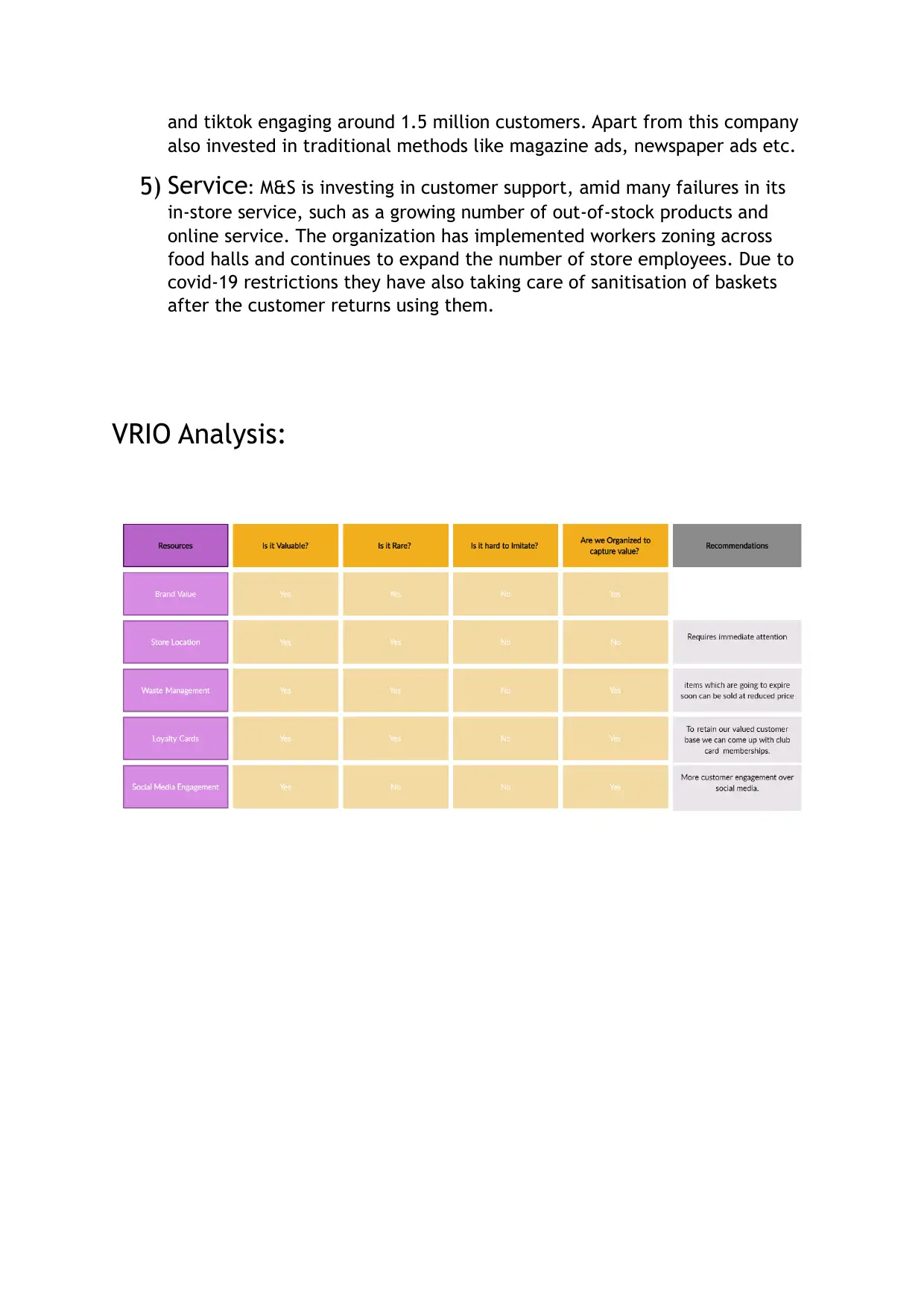
and tiktok engaging around 1.5 million customers. Apart from this company
also invested in traditional methods like magazine ads, newspaper ads etc.
5) Service : M&S is investing in customer support, amid many failures in its
in-store service, such as a growing number of out-of-stock products and
online service. The organization has implemented workers zoning across
food halls and continues to expand the number of store employees. Due to
covid-19 restrictions they have also taking care of sanitisation of baskets
after the customer returns using them.
VRIO Analysis:
also invested in traditional methods like magazine ads, newspaper ads etc.
5) Service : M&S is investing in customer support, amid many failures in its
in-store service, such as a growing number of out-of-stock products and
online service. The organization has implemented workers zoning across
food halls and continues to expand the number of store employees. Due to
covid-19 restrictions they have also taking care of sanitisation of baskets
after the customer returns using them.
VRIO Analysis:
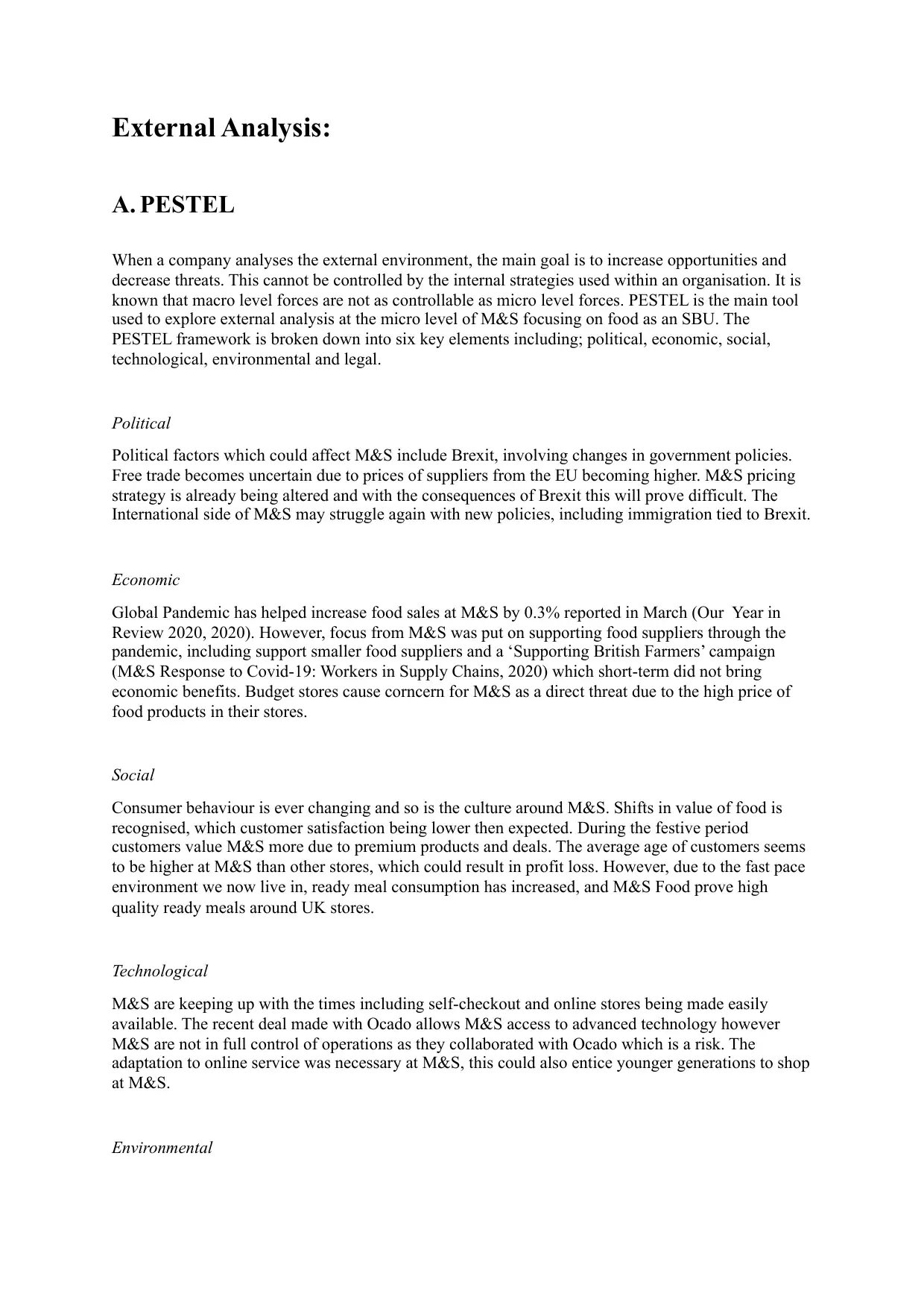
External Analysis:
A. PESTEL
When a company analyses the external environment, the main goal is to increase opportunities and
decrease threats. This cannot be controlled by the internal strategies used within an organisation. It is
known that macro level forces are not as controllable as micro level forces. PESTEL is the main tool
used to explore external analysis at the micro level of M&S focusing on food as an SBU. The
PESTEL framework is broken down into six key elements including; political, economic, social,
technological, environmental and legal.
Political
Political factors which could affect M&S include Brexit, involving changes in government policies.
Free trade becomes uncertain due to prices of suppliers from the EU becoming higher. M&S pricing
strategy is already being altered and with the consequences of Brexit this will prove difficult. The
International side of M&S may struggle again with new policies, including immigration tied to Brexit.
Economic
Global Pandemic has helped increase food sales at M&S by 0.3% reported in March (Our Year in
Review 2020, 2020). However, focus from M&S was put on supporting food suppliers through the
pandemic, including support smaller food suppliers and a ‘Supporting British Farmers’ campaign
(M&S Response to Covid-19: Workers in Supply Chains, 2020) which short-term did not bring
economic benefits. Budget stores cause corncern for M&S as a direct threat due to the high price of
food products in their stores.
Social
Consumer behaviour is ever changing and so is the culture around M&S. Shifts in value of food is
recognised, which customer satisfaction being lower then expected. During the festive period
customers value M&S more due to premium products and deals. The average age of customers seems
to be higher at M&S than other stores, which could result in profit loss. However, due to the fast pace
environment we now live in, ready meal consumption has increased, and M&S Food prove high
quality ready meals around UK stores.
Technological
M&S are keeping up with the times including self-checkout and online stores being made easily
available. The recent deal made with Ocado allows M&S access to advanced technology however
M&S are not in full control of operations as they collaborated with Ocado which is a risk. The
adaptation to online service was necessary at M&S, this could also entice younger generations to shop
at M&S.
Environmental
A. PESTEL
When a company analyses the external environment, the main goal is to increase opportunities and
decrease threats. This cannot be controlled by the internal strategies used within an organisation. It is
known that macro level forces are not as controllable as micro level forces. PESTEL is the main tool
used to explore external analysis at the micro level of M&S focusing on food as an SBU. The
PESTEL framework is broken down into six key elements including; political, economic, social,
technological, environmental and legal.
Political
Political factors which could affect M&S include Brexit, involving changes in government policies.
Free trade becomes uncertain due to prices of suppliers from the EU becoming higher. M&S pricing
strategy is already being altered and with the consequences of Brexit this will prove difficult. The
International side of M&S may struggle again with new policies, including immigration tied to Brexit.
Economic
Global Pandemic has helped increase food sales at M&S by 0.3% reported in March (Our Year in
Review 2020, 2020). However, focus from M&S was put on supporting food suppliers through the
pandemic, including support smaller food suppliers and a ‘Supporting British Farmers’ campaign
(M&S Response to Covid-19: Workers in Supply Chains, 2020) which short-term did not bring
economic benefits. Budget stores cause corncern for M&S as a direct threat due to the high price of
food products in their stores.
Social
Consumer behaviour is ever changing and so is the culture around M&S. Shifts in value of food is
recognised, which customer satisfaction being lower then expected. During the festive period
customers value M&S more due to premium products and deals. The average age of customers seems
to be higher at M&S than other stores, which could result in profit loss. However, due to the fast pace
environment we now live in, ready meal consumption has increased, and M&S Food prove high
quality ready meals around UK stores.
Technological
M&S are keeping up with the times including self-checkout and online stores being made easily
available. The recent deal made with Ocado allows M&S access to advanced technology however
M&S are not in full control of operations as they collaborated with Ocado which is a risk. The
adaptation to online service was necessary at M&S, this could also entice younger generations to shop
at M&S.
Environmental
⊘ This is a preview!⊘
Do you want full access?
Subscribe today to unlock all pages.

Trusted by 1+ million students worldwide
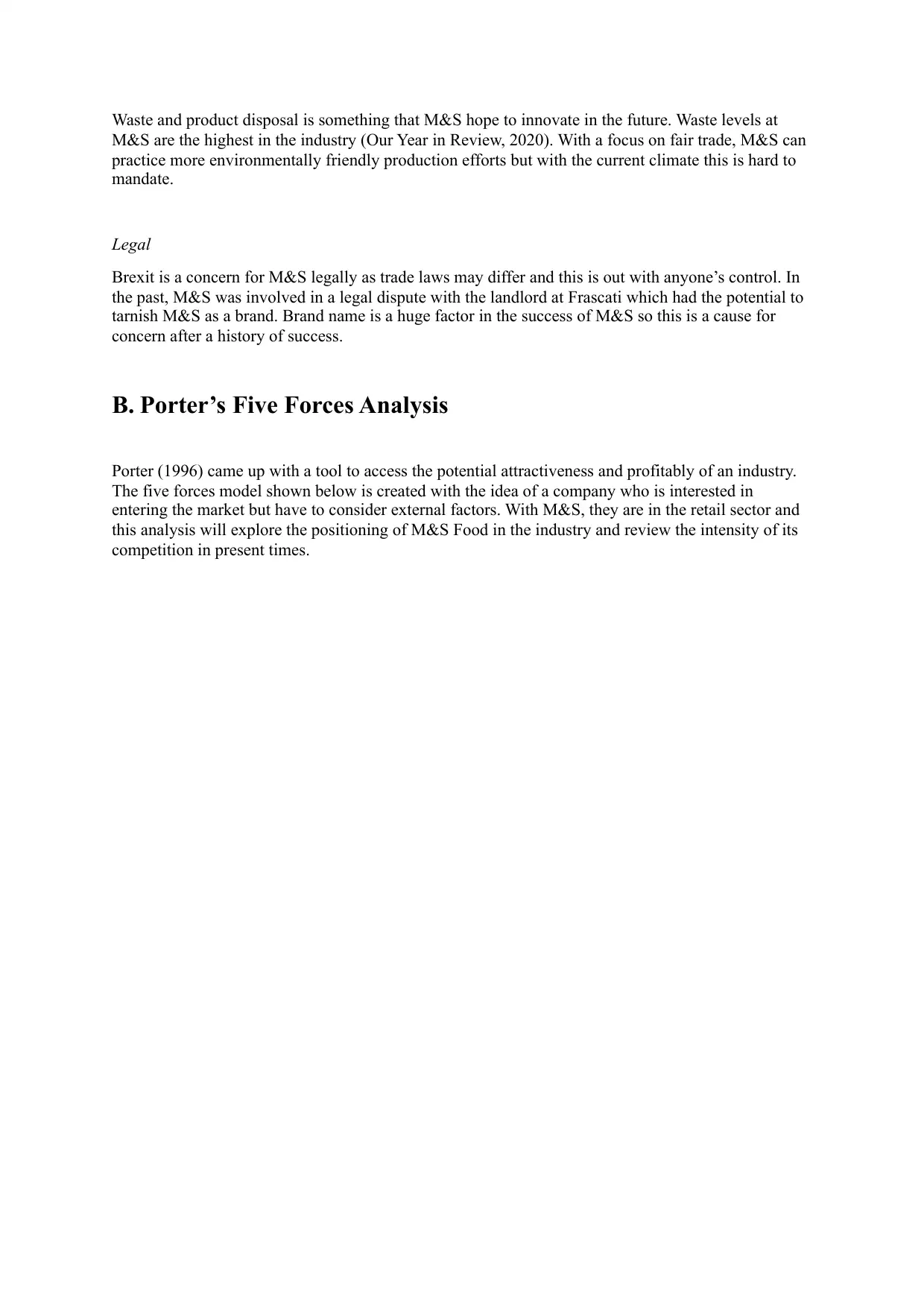
Waste and product disposal is something that M&S hope to innovate in the future. Waste levels at
M&S are the highest in the industry (Our Year in Review, 2020). With a focus on fair trade, M&S can
practice more environmentally friendly production efforts but with the current climate this is hard to
mandate.
Legal
Brexit is a concern for M&S legally as trade laws may differ and this is out with anyone’s control. In
the past, M&S was involved in a legal dispute with the landlord at Frascati which had the potential to
tarnish M&S as a brand. Brand name is a huge factor in the success of M&S so this is a cause for
concern after a history of success.
B. Porter’s Five Forces Analysis
Porter (1996) came up with a tool to access the potential attractiveness and profitably of an industry.
The five forces model shown below is created with the idea of a company who is interested in
entering the market but have to consider external factors. With M&S, they are in the retail sector and
this analysis will explore the positioning of M&S Food in the industry and review the intensity of its
competition in present times.
M&S are the highest in the industry (Our Year in Review, 2020). With a focus on fair trade, M&S can
practice more environmentally friendly production efforts but with the current climate this is hard to
mandate.
Legal
Brexit is a concern for M&S legally as trade laws may differ and this is out with anyone’s control. In
the past, M&S was involved in a legal dispute with the landlord at Frascati which had the potential to
tarnish M&S as a brand. Brand name is a huge factor in the success of M&S so this is a cause for
concern after a history of success.
B. Porter’s Five Forces Analysis
Porter (1996) came up with a tool to access the potential attractiveness and profitably of an industry.
The five forces model shown below is created with the idea of a company who is interested in
entering the market but have to consider external factors. With M&S, they are in the retail sector and
this analysis will explore the positioning of M&S Food in the industry and review the intensity of its
competition in present times.
Paraphrase This Document
Need a fresh take? Get an instant paraphrase of this document with our AI Paraphraser

Figure 1. The Five Forces (Porter, 1996)
Threat of New Entrants
In 2018, M&S began to recognise that their Food business focused highly on premium brands which
in turn lost customer satisfaction. The retail sector is fiercely competitive and full of diversification
which M&S struggled to innovate. Despite the retail sector having a low threat of new entrants, M&S
struggled to compete online with other supermarkets who offered a digital shopping experience. As a
result, M&S partnered with Ocado to expand online grocery shopping and give customers immediate
access to over 6,5000 products (Annual Report & Financial Statements, 2019). M&S prided
themselves in offering quality food however competition worked hard to match this quality through
offering fresh product range. The challenge arose from an outdated supply chain, high in waste with
high operating costs diminishing profits (Annual Report & Financial Statements, 2019). The industry
is attractive for an existing company like M&S because of the difficulty of a new company entering
the UK supermarket industry.
Threat of Substitutes
Threat of substitutes in a supermarket is generally low. Leading supermarkets in the UK, such as
Tesco and Sainsbury’s, have innovated their products and provide a high-quality range of food which
Threat of New Entrants
In 2018, M&S began to recognise that their Food business focused highly on premium brands which
in turn lost customer satisfaction. The retail sector is fiercely competitive and full of diversification
which M&S struggled to innovate. Despite the retail sector having a low threat of new entrants, M&S
struggled to compete online with other supermarkets who offered a digital shopping experience. As a
result, M&S partnered with Ocado to expand online grocery shopping and give customers immediate
access to over 6,5000 products (Annual Report & Financial Statements, 2019). M&S prided
themselves in offering quality food however competition worked hard to match this quality through
offering fresh product range. The challenge arose from an outdated supply chain, high in waste with
high operating costs diminishing profits (Annual Report & Financial Statements, 2019). The industry
is attractive for an existing company like M&S because of the difficulty of a new company entering
the UK supermarket industry.
Threat of Substitutes
Threat of substitutes in a supermarket is generally low. Leading supermarkets in the UK, such as
Tesco and Sainsbury’s, have innovated their products and provide a high-quality range of food which

M&S believed was unique only to them. Finding lower prices at other stores who offer the same
quality range heightened M&S concern around loyal customers and their preferences around pricing.
Substitutes for the food sector of M&S would be off licenses and corner shops attempting to sell fresh
food products which is unlikely, meaning the attractiveness for M&S to stay in this industry stays
high.
Bargaining Powers’ of Buyers
With the concentration of customers being high in retail, M&S Food have high competition. M&S
believed they has to become more relevant with everyday prices that would appeal to their targeted
audience, families (Annual Report & Financial Statements, 2019). During the Christmas period, M&S
saw its biggest success and growth however this was not the case all year round as customers are able
to find similar products elsewhere. It is easy for a customer to switch between competitors because of
this.
Bargaining Power of Suppliers
Threat of supplier power is low at M&S. Having a powerful supplier brand at M&S is why this threat
is low, products are made exclusively for M&S sales only. In turn, M&S are able to use forward
integration to decide their own prices. However, M&S food supply chain is complex with around 400
suppliers who source their materials from 30,000 farms around the world (Supplier Management,
2020). With recent events, such as COVID-19, the supply chain distribution has been disrupted
causing M&S to support suppliers, for example, British Farms. These smaller suppliers needed
financial support during this time which lowered threat of supplier power due to loyalty shown by
M&S.
Rivalry Among Existing Competitors
quality range heightened M&S concern around loyal customers and their preferences around pricing.
Substitutes for the food sector of M&S would be off licenses and corner shops attempting to sell fresh
food products which is unlikely, meaning the attractiveness for M&S to stay in this industry stays
high.
Bargaining Powers’ of Buyers
With the concentration of customers being high in retail, M&S Food have high competition. M&S
believed they has to become more relevant with everyday prices that would appeal to their targeted
audience, families (Annual Report & Financial Statements, 2019). During the Christmas period, M&S
saw its biggest success and growth however this was not the case all year round as customers are able
to find similar products elsewhere. It is easy for a customer to switch between competitors because of
this.
Bargaining Power of Suppliers
Threat of supplier power is low at M&S. Having a powerful supplier brand at M&S is why this threat
is low, products are made exclusively for M&S sales only. In turn, M&S are able to use forward
integration to decide their own prices. However, M&S food supply chain is complex with around 400
suppliers who source their materials from 30,000 farms around the world (Supplier Management,
2020). With recent events, such as COVID-19, the supply chain distribution has been disrupted
causing M&S to support suppliers, for example, British Farms. These smaller suppliers needed
financial support during this time which lowered threat of supplier power due to loyalty shown by
M&S.
Rivalry Among Existing Competitors
⊘ This is a preview!⊘
Do you want full access?
Subscribe today to unlock all pages.

Trusted by 1+ million students worldwide
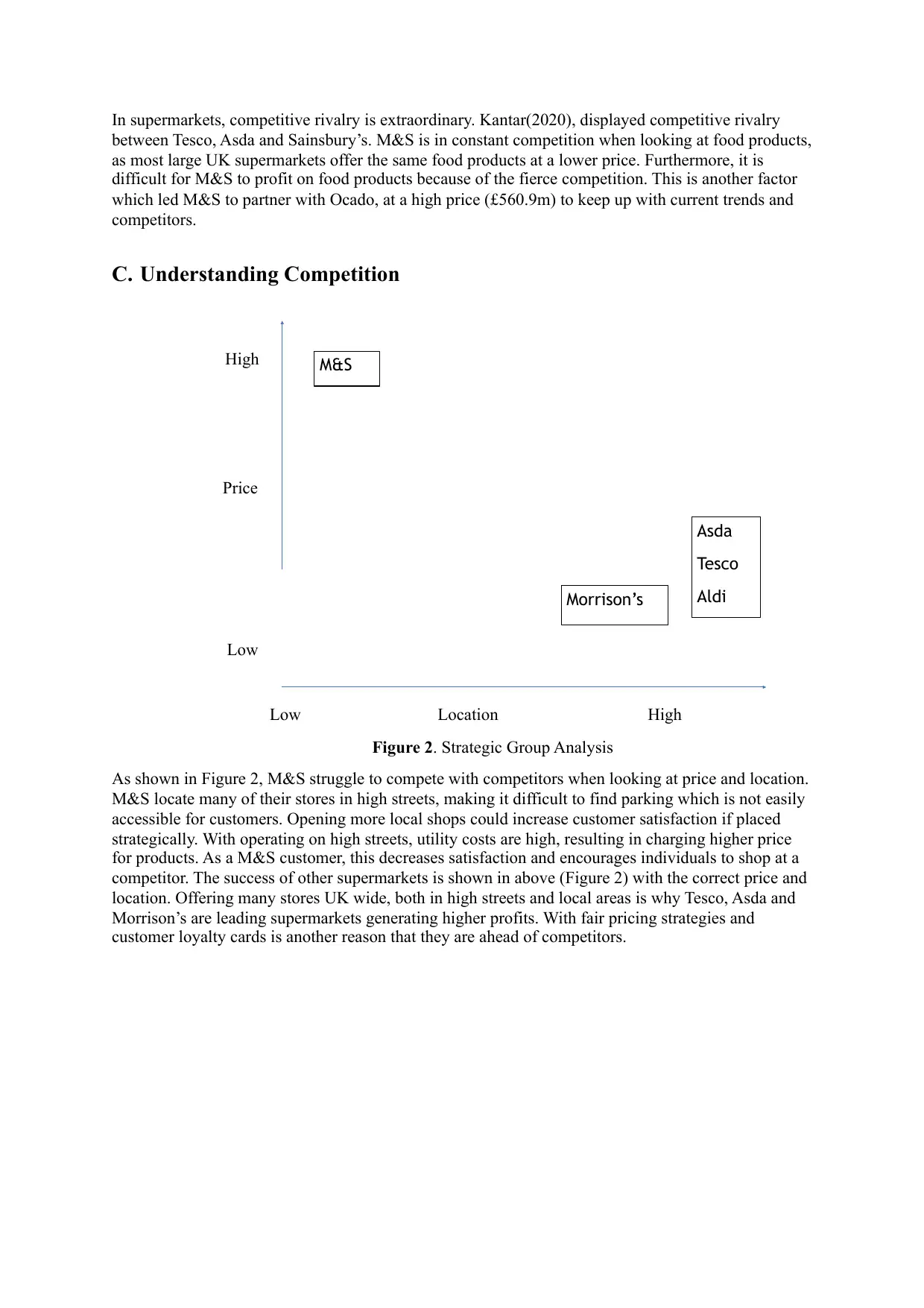
In supermarkets, competitive rivalry is extraordinary. Kantar(2020), displayed competitive rivalry
between Tesco, Asda and Sainsbury’s. M&S is in constant competition when looking at food products,
as most large UK supermarkets offer the same food products at a lower price. Furthermore, it is
difficult for M&S to profit on food products because of the fierce competition. This is another factor
which led M&S to partner with Ocado, at a high price (£560.9m) to keep up with current trends and
competitors.
C. Understanding Competition
High
Price
Low
Low Location High
Figure 2. Strategic Group Analysis
As shown in Figure 2, M&S struggle to compete with competitors when looking at price and location.
M&S locate many of their stores in high streets, making it difficult to find parking which is not easily
accessible for customers. Opening more local shops could increase customer satisfaction if placed
strategically. With operating on high streets, utility costs are high, resulting in charging higher price
for products. As a M&S customer, this decreases satisfaction and encourages individuals to shop at a
competitor. The success of other supermarkets is shown in above (Figure 2) with the correct price and
location. Offering many stores UK wide, both in high streets and local areas is why Tesco, Asda and
Morrison’s are leading supermarkets generating higher profits. With fair pricing strategies and
customer loyalty cards is another reason that they are ahead of competitors.
Asda
Tesco
Aldi
M&S
Morrison’s
between Tesco, Asda and Sainsbury’s. M&S is in constant competition when looking at food products,
as most large UK supermarkets offer the same food products at a lower price. Furthermore, it is
difficult for M&S to profit on food products because of the fierce competition. This is another factor
which led M&S to partner with Ocado, at a high price (£560.9m) to keep up with current trends and
competitors.
C. Understanding Competition
High
Price
Low
Low Location High
Figure 2. Strategic Group Analysis
As shown in Figure 2, M&S struggle to compete with competitors when looking at price and location.
M&S locate many of their stores in high streets, making it difficult to find parking which is not easily
accessible for customers. Opening more local shops could increase customer satisfaction if placed
strategically. With operating on high streets, utility costs are high, resulting in charging higher price
for products. As a M&S customer, this decreases satisfaction and encourages individuals to shop at a
competitor. The success of other supermarkets is shown in above (Figure 2) with the correct price and
location. Offering many stores UK wide, both in high streets and local areas is why Tesco, Asda and
Morrison’s are leading supermarkets generating higher profits. With fair pricing strategies and
customer loyalty cards is another reason that they are ahead of competitors.
Asda
Tesco
Aldi
M&S
Morrison’s
Paraphrase This Document
Need a fresh take? Get an instant paraphrase of this document with our AI Paraphraser
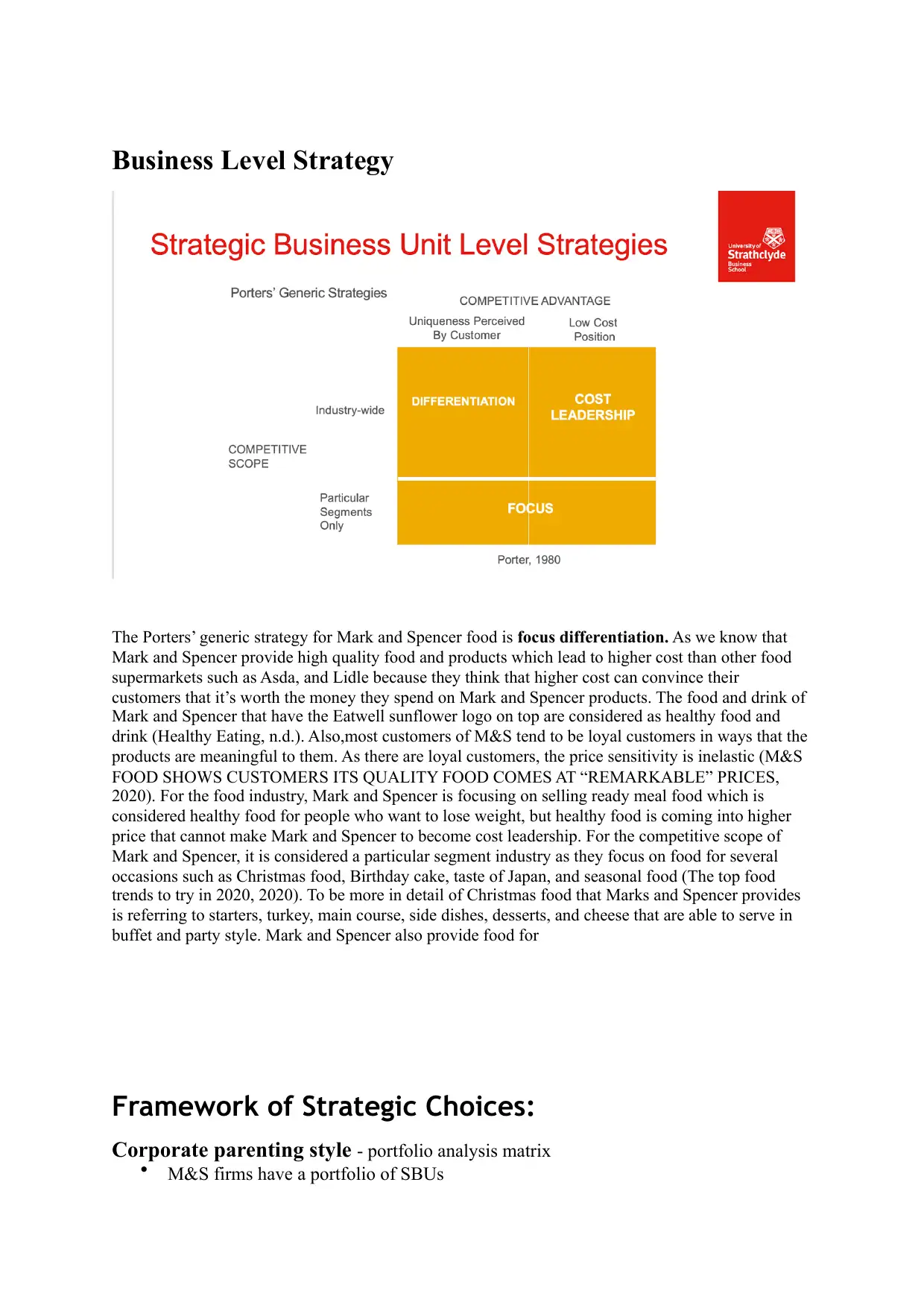
Business Level Strategy
The Porters’ generic strategy for Mark and Spencer food is focus differentiation. As we know that
Mark and Spencer provide high quality food and products which lead to higher cost than other food
supermarkets such as Asda, and Lidle because they think that higher cost can convince their
customers that it’s worth the money they spend on Mark and Spencer products. The food and drink of
Mark and Spencer that have the Eatwell sunflower logo on top are considered as healthy food and
drink (Healthy Eating, n.d.). Also,most customers of M&S tend to be loyal customers in ways that the
products are meaningful to them. As there are loyal customers, the price sensitivity is inelastic (M&S
FOOD SHOWS CUSTOMERS ITS QUALITY FOOD COMES AT “REMARKABLE” PRICES,
2020). For the food industry, Mark and Spencer is focusing on selling ready meal food which is
considered healthy food for people who want to lose weight, but healthy food is coming into higher
price that cannot make Mark and Spencer to become cost leadership. For the competitive scope of
Mark and Spencer, it is considered a particular segment industry as they focus on food for several
occasions such as Christmas food, Birthday cake, taste of Japan, and seasonal food (The top food
trends to try in 2020, 2020). To be more in detail of Christmas food that Marks and Spencer provides
is referring to starters, turkey, main course, side dishes, desserts, and cheese that are able to serve in
buffet and party style. Mark and Spencer also provide food for
Framework of Strategic Choices:
Corporate parenting style - portfolio analysis matrix
• M&S firms have a portfolio of SBUs
The Porters’ generic strategy for Mark and Spencer food is focus differentiation. As we know that
Mark and Spencer provide high quality food and products which lead to higher cost than other food
supermarkets such as Asda, and Lidle because they think that higher cost can convince their
customers that it’s worth the money they spend on Mark and Spencer products. The food and drink of
Mark and Spencer that have the Eatwell sunflower logo on top are considered as healthy food and
drink (Healthy Eating, n.d.). Also,most customers of M&S tend to be loyal customers in ways that the
products are meaningful to them. As there are loyal customers, the price sensitivity is inelastic (M&S
FOOD SHOWS CUSTOMERS ITS QUALITY FOOD COMES AT “REMARKABLE” PRICES,
2020). For the food industry, Mark and Spencer is focusing on selling ready meal food which is
considered healthy food for people who want to lose weight, but healthy food is coming into higher
price that cannot make Mark and Spencer to become cost leadership. For the competitive scope of
Mark and Spencer, it is considered a particular segment industry as they focus on food for several
occasions such as Christmas food, Birthday cake, taste of Japan, and seasonal food (The top food
trends to try in 2020, 2020). To be more in detail of Christmas food that Marks and Spencer provides
is referring to starters, turkey, main course, side dishes, desserts, and cheese that are able to serve in
buffet and party style. Mark and Spencer also provide food for
Framework of Strategic Choices:
Corporate parenting style - portfolio analysis matrix
• M&S firms have a portfolio of SBUs

• BCG matrix (Growth, launch, maturity, decline)
(Below are some ideas of which sections things may fall under)
As a long-standing UK business, M&S’ differentiation strategy emphasised quality and value
at a premium price but neglected a key founding value, that of innovation.
M&S should try and look at product development.
For this analysis of M&S SBU, a more traditional analysis was used to evaluate strategic
choice. The analysis is separated into 3 distinct categories; suitability, feasibility and accept-
ability. Four strategies were suggested by our group and decided through following simple
steps.
Feasibility:
1. Does this strategy address environmental factors?
Star (Growth)
-M&S.com
- Food products
- Marketing
Dogs (decline)
• Premium price clothing
• Electronics
Cash cows (maturity)
-Packaging
- Expiration date
Delivery service
Question Marks (launch)
• Menswear & kidswear
• Womenswear
• M&S Bank
• Target customers
(Below are some ideas of which sections things may fall under)
As a long-standing UK business, M&S’ differentiation strategy emphasised quality and value
at a premium price but neglected a key founding value, that of innovation.
M&S should try and look at product development.
For this analysis of M&S SBU, a more traditional analysis was used to evaluate strategic
choice. The analysis is separated into 3 distinct categories; suitability, feasibility and accept-
ability. Four strategies were suggested by our group and decided through following simple
steps.
Feasibility:
1. Does this strategy address environmental factors?
Star (Growth)
-M&S.com
- Food products
- Marketing
Dogs (decline)
• Premium price clothing
• Electronics
Cash cows (maturity)
-Packaging
- Expiration date
Delivery service
Question Marks (launch)
• Menswear & kidswear
• Womenswear
• M&S Bank
• Target customers
⊘ This is a preview!⊘
Do you want full access?
Subscribe today to unlock all pages.

Trusted by 1+ million students worldwide
1 out of 18
Related Documents
Your All-in-One AI-Powered Toolkit for Academic Success.
+13062052269
info@desklib.com
Available 24*7 on WhatsApp / Email
![[object Object]](/_next/static/media/star-bottom.7253800d.svg)
Unlock your academic potential
Copyright © 2020–2025 A2Z Services. All Rights Reserved. Developed and managed by ZUCOL.




